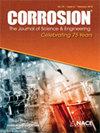Effects of Hydrodynamic Environment on the Interaction of Shewanella oneidensis with Low Carbon Steel and the Impacts on Corrosion
IF 1.1
4区 材料科学
Q4 MATERIALS SCIENCE, MULTIDISCIPLINARY
引用次数: 0
Abstract
Microbiologically influenced corrosion (MIC) impacts various industries such as oil/gas production and transmission, wastewater treatment, power generation, and chemical processing. In such settings, the combined impacts of microbiological activities and fluid flow dynamics could be primary controllers of metal corrosion. We examined the relative influences of fluid flow and the activities of the facultative Fe(III) reducing bacterium, Shewanella oneidensis MR-1, on the corrosion of carbon steel. Rotating cylinder electrode experiments were used to determine the shear stress and velocity at the surface of the metal coupon in a newly constructed flow system. The system was then used to study the impact of increasing fluid velocity and shear stress on the corrosion rate of coupons in O2-limited and O2-non-limited incubations. Confocal scanning laser microscopy was used to monitor biofilm development on the metal surface at increasing shear stress. We found that the activities of S. oneidensis inhibited corrosion, even under conditions of high shear stress and limited attachment, indicating that the respiratory consumption of O2 by planktonic S. oneidensis protects the metal surface from enhanced corrosion.水动力环境对谢瓦氏菌与低碳钢相互作用的影响及其对腐蚀的影响
微生物影响腐蚀(MIC)影响着石油/天然气生产和输送、废水处理、发电和化学加工等多个行业。在这种环境下,微生物活动和流体流动动力学的综合影响可能是金属腐蚀的主要控制因素。我们研究了流体流动和兼性铁(III)还原细菌希瓦氏菌MR-1的活性对碳钢腐蚀的相对影响。采用旋转圆柱体电极实验对新建立的流动系统中金属接头表面的剪应力和速度进行了测定。然后使用该系统研究了在限氧和无限氧孵育中流体速度和剪切应力的增加对薄片腐蚀速率的影响。采用激光共聚焦扫描显微技术,监测了剪切应力增大时金属表面生物膜的发育情况。我们发现,即使在高剪切应力和有限附着的条件下,臭草的活性也能抑制腐蚀,这表明浮游臭草呼吸消耗氧气可以保护金属表面免受增强的腐蚀。
本文章由计算机程序翻译,如有差异,请以英文原文为准。
求助全文
约1分钟内获得全文
求助全文
来源期刊

Corrosion
MATERIALS SCIENCE, MULTIDISCIPLINARY-METALLURGY & METALLURGICAL ENGINEERING
CiteScore
2.80
自引率
12.50%
发文量
97
审稿时长
3 months
期刊介绍:
CORROSION is the premier research journal featuring peer-reviewed technical articles from the world’s top researchers and provides a permanent record of progress in the science and technology of corrosion prevention and control. The scope of the journal includes the latest developments in areas of corrosion metallurgy, mechanisms, predictors, cracking (sulfide stress, stress corrosion, hydrogen-induced), passivation, and CO2 corrosion.
70+ years and over 7,100 peer-reviewed articles with advances in corrosion science and engineering have been published in CORROSION. The journal publishes seven article types – original articles, invited critical reviews, technical notes, corrosion communications fast-tracked for rapid publication, special research topic issues, research letters of yearly annual conference student poster sessions, and scientific investigations of field corrosion processes. CORROSION, the Journal of Science and Engineering, serves as an important communication platform for academics, researchers, technical libraries, and universities.
Articles considered for CORROSION should have significant permanent value and should accomplish at least one of the following objectives:
• Contribute awareness of corrosion phenomena,
• Advance understanding of fundamental process, and/or
• Further the knowledge of techniques and practices used to reduce corrosion.
 求助内容:
求助内容: 应助结果提醒方式:
应助结果提醒方式:


